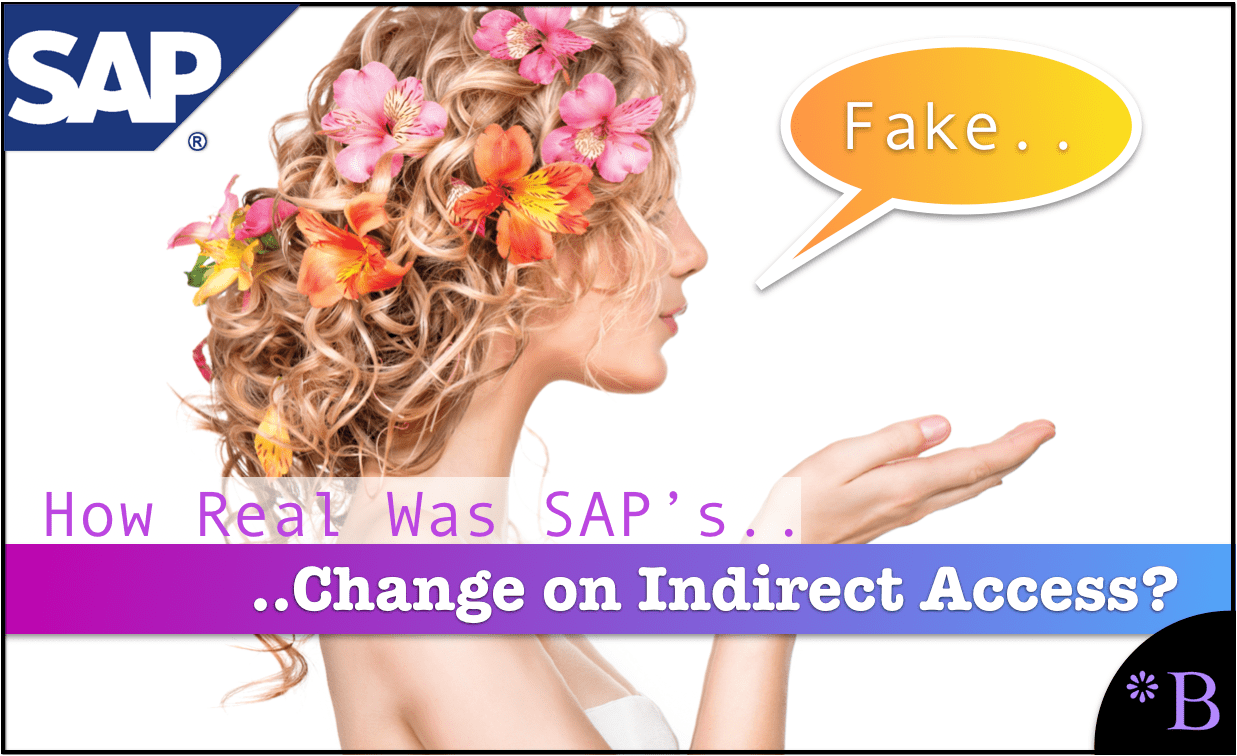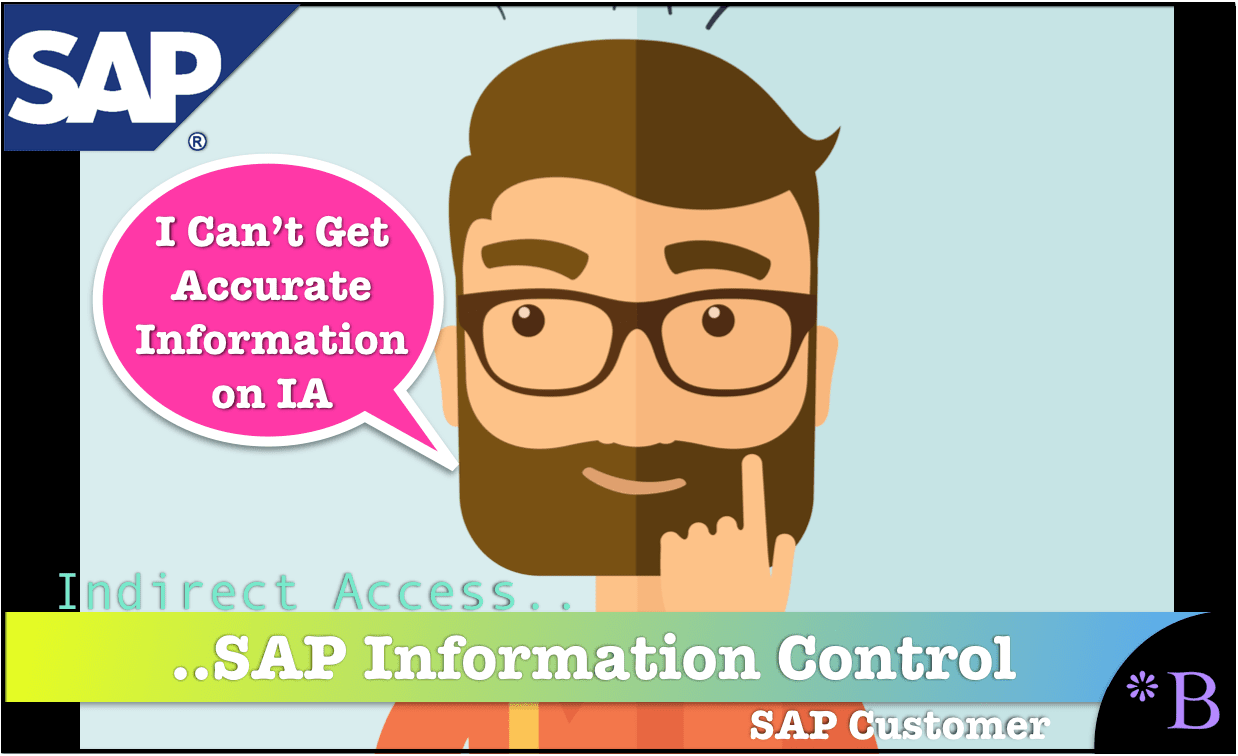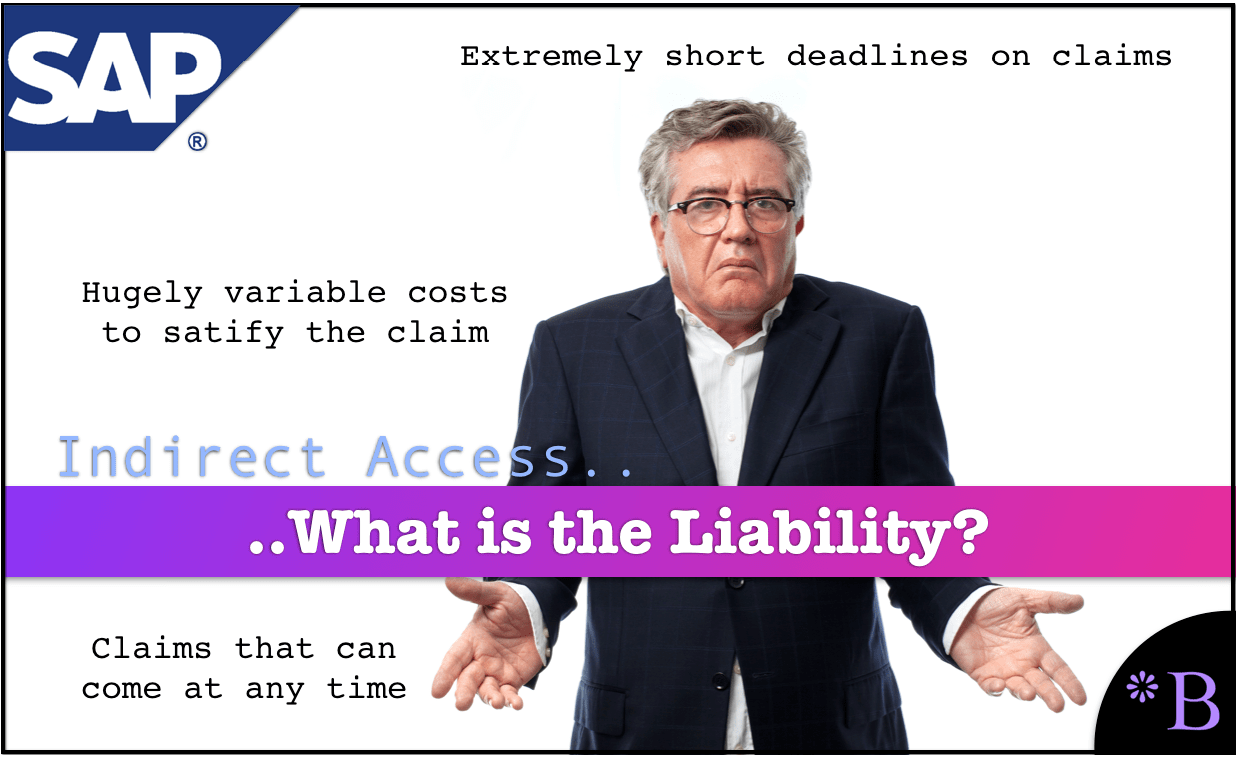How to Best Understand SAP Faux Change on Indirect Access
Executive Summary
- SAP announced a new policy on indirect access, which was announced at SAPPHIRE 2017.
- We analyze this new policy and how different it is from how IT media covered this policy.

Introduction
There has been a lot of Twitter activity, and people emailing each other on the SAPPHIRE announced a change of policy on indirect access by SAP. This article analyzes the article titled Modern Pricing for Modern Times, published on SAP’s website the same day as the announcement.
Our References for This Article
If you want to see our references for this article and other related Brightwork articles, see this link.
Notice of Lack of Financial Bias: We have no financial ties to SAP or any other entity mentioned in this article.
- This is published by a research entity, not some lowbrow entity that is part of the SAP ecosystem.
- Second, no one paid for this article to be written, and it is not pretending to inform you while being rigged to sell you software or consulting services. Unlike nearly every other article you will find from Google on this topic, it has had no input from any company's marketing or sales department. As you are reading this article, consider how rare this is. The vast majority of information on the Internet on SAP is provided by SAP, which is filled with false claims and sleazy consulting companies and SAP consultants who will tell any lie for personal benefit. Furthermore, SAP pays off all IT analysts -- who have the same concern for accuracy as SAP. Not one of these entities will disclose their pro-SAP financial bias to their readers.
SAP’s on Its Change
SAP’s Faux Concern on Pricing Transparency
“Among the many topics that SAP has made progress on over the past year is one that we don’t talk too publicly about: Corporate Pricing and Licensing. We recognize that traditional approaches to business are being replaced by newer, more transparent, modern ways of thinking and acting. Which is why we are committed to modernizing our pricing approach.”
SAP uses opaque pricing, and they always have. SAP not only keeps its pricing a secret but on its price list, it states the following:
“All rights reserved. The contents of this work are confidential and proprietary information of SAP AG. Improper and/or unauthorized reproduction in whole or in part of the information contained in this work is a violation of SAP’s proprietary rights and could cause irreparable damage. No part of this work may be reproduced or copied in whole or in part in any form or by any means (including without limitation graphic, electronic, or mechanical, including photocopying, recording, taping or information storage and retrieval systems) without the prior written permission of the publisher.”
Therefore, their pricing information becoming known could cause SAP irreparable damage. Why? This paragraph exists to scare people that have the list into not publishing any information on SAP’s pricing under the impression that they could be sued. But they could not be sued as pricing is not intellectual property. This paragraph tells you how much SAP wants no one to know what their pricing is.
This paragraph exists to scare people that have the list into not publishing any information on SAP’s pricing under the impression that they could be sued. But they could not be sued as pricing is not intellectual property. This paragraph tells you how much SAP wants no one to know what their pricing is. This is the same as Ford stating that if its trucks’ price were known, that would cause Ford irreparable damage.
The SAP pricing is highly complex and is found in the SAP Pricing List, which still does not tell you what the actual pricing is. This is because it also depends on other factors such as the particular account, the maturing of the application, the region where the customer is based, among other factors. SAP keeps its pricing as complicated as possible so that prices can’t be compared. This is the opposite of SaaS pricing, a type of pricing where the price is published on the vendor’s website. SAP is receiving pressure to move to more transparent pricing because customers are getting used to companies like Salesforce or PlanetTogether that can determine a price without even having to engage with a sales rep. Published pricing has a long history and helps move markets to greater efficiency.
“Today’s technology landscapes are dynamic, interconnected and mission critical to the health and success of any business. In an agile world where digital reigns supreme, licensing complexity is getting in the way of innovation.”
Type 1 Versus Type 2 Indirect Access
SAP is the only vendor that has created its definition of indirect access, which enlarges the actual meaning. For details on the difference, see Type 1 Versus Type 2 Indirect Access. Therefore it is quite ridiculous for SAP to bring up superfluous comments about landscapes being dynamic and interconnected. SAP has interfered with this through their application of fake indirect access. So now, SAP is in favor of openness? Of all the vendors, SAP has the highest licensing complexity and has for all of its existence, and they kept this because, in their view, it allowed them to get the most money from their customers.
This is a bit like Donald Trump’s press conference where he stated that Hillary Clinton started the birther issue, but he “finished it” when it was good old Donnie that promoted the birther issue a talking point for a year and a half. Another analogy would be a vampire holding a press conference to decry that too many people have been getting bitten recently.
“As we spoke to our user groups about how to specifically address this, the topic of indirect access repeatedly came up. Indirect access is a term created by our user groups to describe when a user accesses the SAP system via a third party or custom-made software.”
So a deliberately false statement. Type 1 indirect access is one thing. Type 2 indirect access is what SAP enforces and which only SAP enforces, which is an illogical and rapacious enlargement of indirect access. The term indirect access was also not created by SAP’s user groups.
“We decided to tackle this topic first through the lens of pricing modernization. Our objective was to make pricing predictable, linked to unit of value, transparent, and consistently applied.”
SAP is not first tackling this issue in this article; they addressed this issue by repeatedly intimidating their customers with trumped-up indirect access claims. SAP has never had any objection to keeping pricing predictable linked to value. SAP’s pricing is about secrecy and extracting the most substantial amount from its customers. And it always has been.
SAP’s intent here is becoming clear at this point in the announcement.
SAP received a great deal of pushback from customers due to the Diageo and InBev fiascos. The account managers have stated that they are facing a potential for declining revenue due to this. Remember, SAP always does the wrong thing for customers, so they only change a policy when it increases revenues.
Any statement that SAP makes regarding looking out for their customer’s interests can be put alongside similar comments from IBM or Goldman Sachs.
“So what did we do?
We looked first at the areas that would have the greatest impact on the greatest number of people. We found that approximately 80 percent of our ERP customers will benefit from our changes to just these three scenarios: Procure-to-Pay, Order-to-Cash, and Indirect Static Read.”
No. SAP found that they could benefit (make more money) if they changed their ERP customers’ three scenarios. SAP should not be charging indirect access for these scenarios or any other scenarios under their indirect access interpretation. All that SAP is doing here is rolling back some of the indirect access scenarios that no other vendor enforces.
Indirect Access Pricing Changes
- We believe value is measured by outcomes. Therefore, our pricing model for the Procure-to-Pay and Order-to-Cash scenarios in ERP (ECC or SAP S/4HANA) will now be based on orders, a measurable business outcome for any business.
SAP does not care about its customers’ value; its sales reps are only measured by the value delivered to SAP. SAP implementations often have very problematic “outcomes” for their customers, which has never mattered much to SAP.
SAP Moves to a New Pricing Scheme for Sales Orders and Purchase Orders
And this seems to propose that customers who should not be charged any of SAP’s Type 2 indirect access for procure-to-pay and order-to-cash will now have to pay indirect access fees on a transaction basis. All that has happened is that how SAP gets paid on its false indirect access claims for these two scenarios has changed. This may cost more or less than the previous pricing scheme that SAP had in place.
Why Would SAP Ever Own Their Customer’s Data?
- Indirect static read access reinforces that a customer’s data is yours. Just because the data was in the SAP system, does not mean you should pay to view it when it is outside the SAP system.
How could it be otherwise? Does a software vendor really have to clarify this? How many applications does SAP think they would sell if they told their customers that SAP owns all of their data as soon as they implement SAP? This statement by SAP seems intended to sound magnanimous, but what if I told you that just because you invited me into your home that all your possessions were yours and not mine?
This should go without saying.
“Indirect static read is read-only that is not related to a real-time system inquiry or request and requires no processing or computing in SAP system. Indirect Static Read will now be included in the underlying software license – i.e. free of additional charge when a customer is otherwise properly licensed. SAP leads the pack in addressing customer expectations related to this scenario.”
This is the most crucial part of the announcement because most of the change is located. And at first blush, it looks good for customers. But I have a concern with SAP’s use of the term “Static Read.” This is because Static Read is not a real term in databases. Operations are read, write, update. So one has to ask why SAP uses the word “static” in front of the word “read.” My concern is that SAP is giving itself a way to wiggle out of this commitment. So they can claim that a read at a customer is not static for some reason that they make up. Given that SAP continually does this, I now don’t know what this paragraph means in practice. When SAP creates its terminology, it means that the ball is in SAP’s court to define that terminology. If anyone has any idea what a static read is, please comment below.
More Commentary on Value-Based Pricing
“Changes are designed to focus on outcomes/value related to the use of SAP software and are available to customers via licensing/contract amendment.*”
This sentence can be disregarded. It is a restatement of SAP’s false proposal about focusing on customer outcomes.
Conflating Type 2 Indirect Access with Normal Licensing
“If you’re fully licensed, there’s no action for you. However, if you’re questioning whether you are under- licensed, let’s talk about it. We want customers to proactively engage us on this topic. SAP assures customers who proactively engage with SAP to resolve such under-licensing of SAP software that we will not collect back maintenance payments for such under-licensing. We will look at your specific circumstances when resetting your licensing agreement, including providing you the opportunity to receive credit for certain products you may have already licensed so you can update to the new metrics.”
Here SAP states that if you don’t follow its illogical Type 2 indirect access proposal, you are “under licensed.” SAP started by redefining the term indirect access to meet its revenue objectives. It then redefines the term under licensed to be based upon this foundation. SAP is looking for its customers to approach SAP and to approach SAP uninformed, hopefully. The SAP account manager can then leverage false proposals about indirect access to make it appear as if the customer has liability and uncontestable liability. The account manager will then pull out a menu of SAP offerings, various applications that the customer can purchase (hopefully HANA!) to redress the false charge of Type 2 indirect access. It is most desirable if the customer never speaks of the experience, and SAP would like to keep this as quiet as possible.
The threat is, of course, very apparent that if you don’t approach SAP “proactively,” SAP will punish you with back maintenance payments on a violation that never occurred.
“Does this address every indirect access scenario in the age of devices, IoT, and collaborative networks? Not yet. There is much more to do and we are eager to keep updating pricing scenarios to bring you greater value. It is, however, a step in the right direct toward pricing modernization.”
This announcement does not address anything. We have a change in pricing on indirect access for sales orders and purchase orders that customers should not have to pay for in the first place, and a nebulous statement about static read, which we have to observe through SAP’s actions what that means.
“Customers that want to win in a modern, digital world need a partner that is willing to reimagine their own processes to drive success in a digital economy. What I can assure every customer is that at SAP — with the unwavering support of CEO Bill McDermott and every SAP employee — is that your voice matters. When customers speak, SAP listens. In my view, that’s the hallmark of a world-class, customer-focused business.
Who could say it better than Bill McDermott? “We can evolve we can improve, and we will. SAP will remain a culture always in pursuit of excellence.”
Wow, that is a lot of fluff. Bill McDermott is, as Hasso Plattner said when he replaced Leo Apotheker with him, a “happy face.” Bill McDermott is an effective spokesperson who creates a friendly face for underneath the facade, an iron fist.
Conclusion
- This announcement is filled with numerous falsehoods that indicate SAP is not taking an honest approach to this issue.
- SAP intends to mislead the SAP customer base into lowering their guard by making a few slight modifications to indirect access that may end up amounting to as close as possible to zero change in SAP’s enforcement of indirect access.
- SAP wants to continue to enforce its version of indirect access (Type 2) in secret while reducing its customers’ pushback and concern. This announcement has everything to do with managing the perception and guard lowering while offering nothing of substance on the actual enforcement of indirect access.

The Problem: Secrecy Around Indirect Access
Oracle, SAP, and their consulting partners, ASUG, and the IT media entities all, have something in common. They don’t want indirect access understood. Media outlets like Diginomica are paid to distribute PR releases as articles, as we covered in the article SAP’s Recycled Indirect Access Damage Control for 2018. The intent is to lower SAP customers’ concern around indirect access so that indirect access is underestimated, as we covered in the article The Danger in Underestimating SAP Indirect Access.

The primary providers of information in the SAP space are all financially linked to SAP. SAP does not want indirect access understood, so these entities do as they are told by SAP.